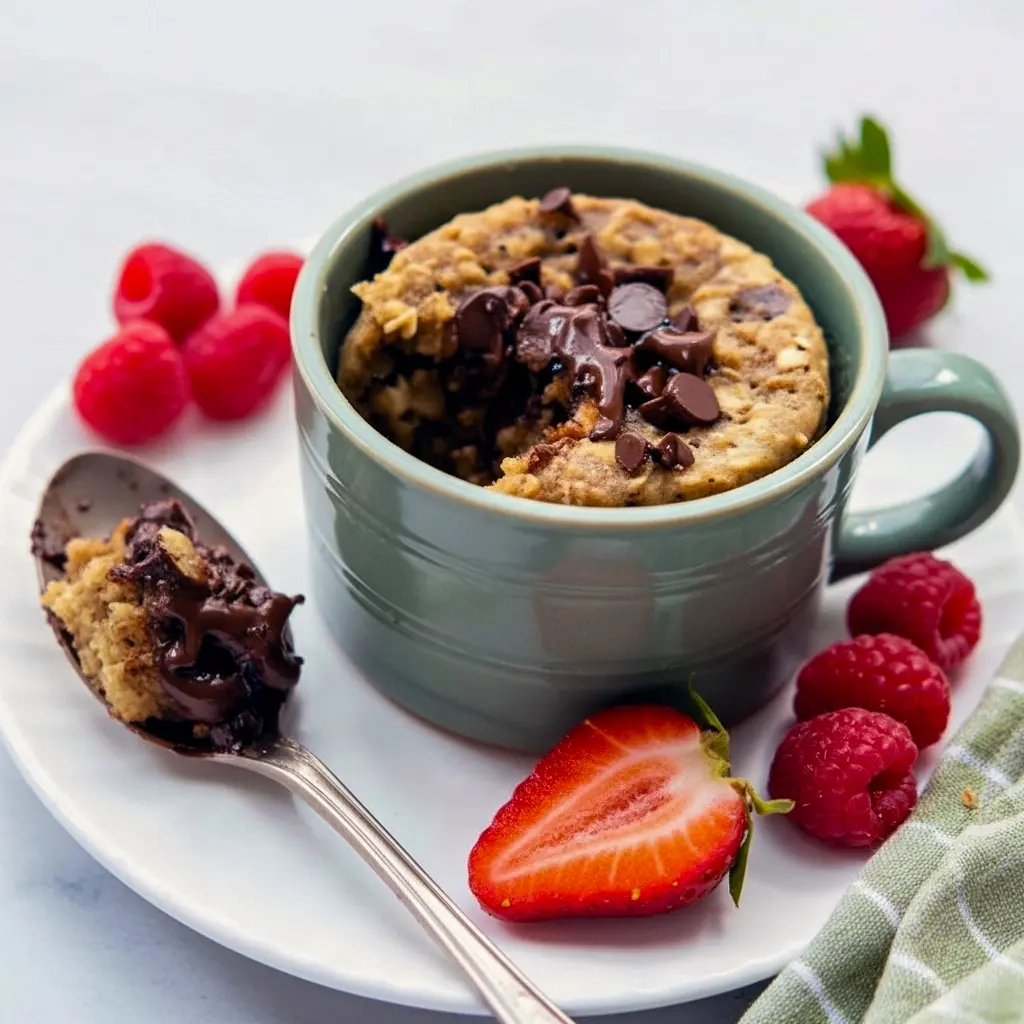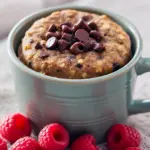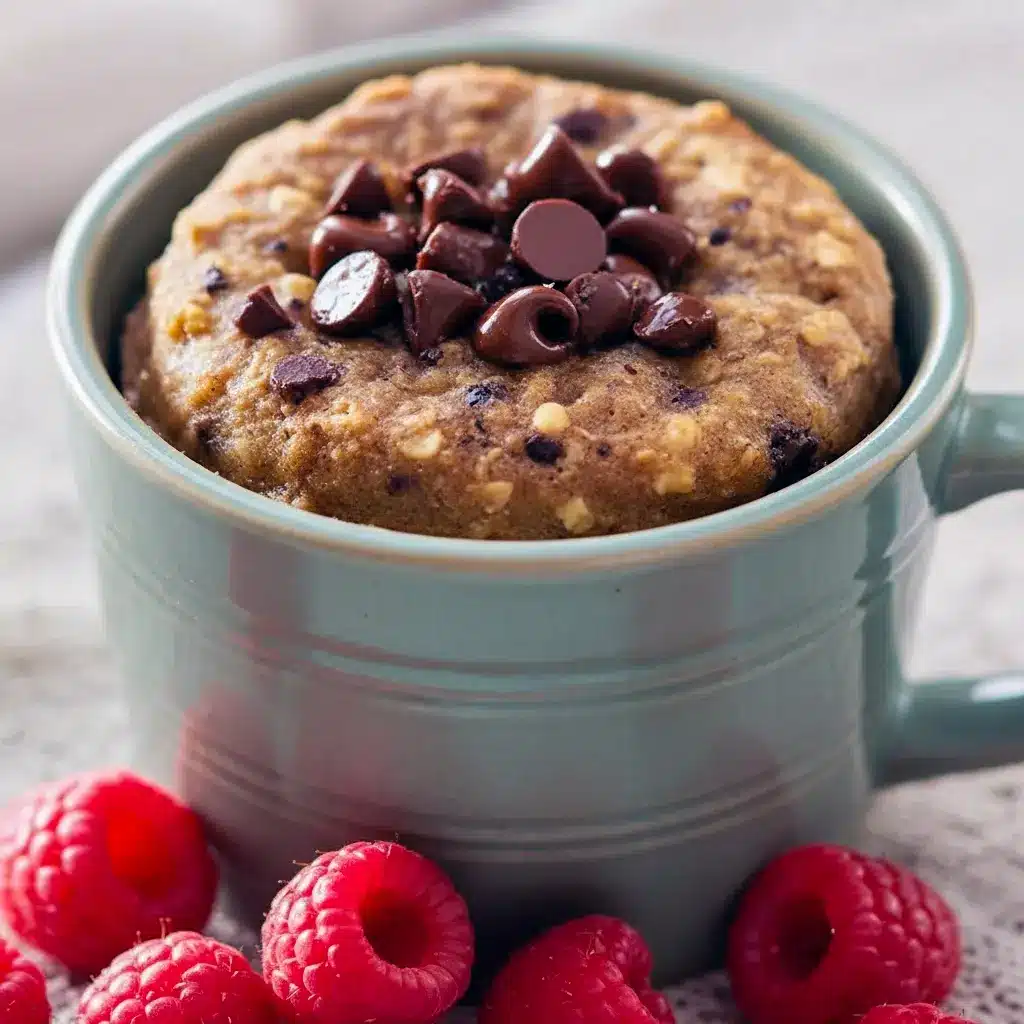Oatmeal Mug Cake Recipe is the microwave miracle you didn’t know you needed: a single-serving, fluffy, flourless cake made from oats, ready in about two minutes. Seriously — three minutes if you count the dramatic first bite. This recipe gives you a warm, slightly cakey, slightly gooey treat that doubles as a quick breakfast or a late-night dessert. Want it gluten-free? Done. Want it dairy-free? Swap the milk. Want it to feel like bakery-level indulgence with zero fuss? Keep reading.
Introduction to the Oatmeal Mug Cake Recipe
This mug cake uses only pantry-friendly staples — oats (or oat flour), an egg, a splash of milk, a little sweetener, oil, and baking powder. No wheat flour, no fancy equipment, and — most importantly — no guilt. It’s a perfect Easy Dessert Ideas For One that also qualifies as a Quick Gluten-free Snack when you use certified gluten-free oats. The real trick? A halfway stir that keeps the egg from clumping and stops the microwave from turning the cake rubbery. Trust me: stirring halfway is the hack that makes this mug cake actually taste like cake.
What makes this recipe so irresistible?
Texture. Speed. Versatility. You get a cake that’s fluffy yet moist, with a tender crumb and crisp-ish edges. The oats give body and a comforting whole-grain flavor, while the egg and a touch of oil keep everything tender. Want a breakfast that feels like dessert? This does the job. Want a dessert that feels wholesome? Also yes.
And the toppings — oh, the toppings. Fresh berries, a spoonful of nut butter, a swirl of yogurt, or that guilty pleasure: a tiny scoop of ice cream. Each option changes the mood, and the base holds up to them all.
Ingredients (short descriptions)
- Quick oats or oat flour — the base; quick oats absorb fast and give the lightest cake in the microwave.
- Egg — binds and provides lift; the egg is why this cake tastes like cake and not just baked oatmeal.
- Milk — any milk works; dairy or plant-based. It hydrates the oats and adds tenderness.
- Oil — keeps the cake moist; neutral oil, melted coconut, or even nut butter all work.
- Sweetener — maple syrup gives great flavor; brown sugar or honey also work. Reduce if you want less sweet.
- Baking powder — the little lift agent that makes the cake fluffy. Don’t skip it.
- Salt & cinnamon (optional) — salt brightens flavors; cinnamon adds cozy warmth.
- Optional mix-ins — mini chocolate chips, mashed banana (swap egg), chopped nuts, or berries.
Simple how-to: make this single-serve cake
- Prep your mug — Use a microwave-safe mug (10 oz or larger) and spray it lightly with nonstick spray.
- Whisk wet ingredients — In the mug, whisk the egg, milk, oil, sweetener, and vanilla until smooth.
- Add dry ingredients — Stir in oats (or oat flour), baking powder, a pinch of salt, and cinnamon if using. Mix until combined.
- Microwave — halfway stir trick — Microwave on high for 45 seconds, then stop and stir vigorously to redistribute the egg and stop hot spots. Return to the microwave for 45–60 seconds more. Microwaves vary — watch the cake rise but avoid overcooking.
- Top & enjoy — Let it cool a minute, then add your favorite topping.
Bold tip: stirring halfway through cooking prevents rubbery eggs and gives a uniform, fluffy crumb.
The story behind this little cake
I fell in love with mug cakes because I wanted cake without commitment — one portion, no loaf pan, no sharing if I didn’t want to. The oatmeal version came from lazy pantry creativity: out of flour, but full of oats and banana, so I experimented. After a few tweaks — grinding oats for oat flour, testing egg vs. banana swaps, and discovering the halfway stir — this recipe became my go-to. It’s perfect for when you want dessert but also want to feel like a reasonable, functioning adult the next morning. FYI, that’s a rare win.
Pro tips for the best outcome
- Use quick oats or oat flour for the fluffiest texture. If you only have rolled oats, blitz them in a blender for 30–45 seconds to simulate oat flour.
- Measure liquids carefully. Too much milk yields a dense, wet cake; too little makes it dry. Start with the recommended amount and adjust next time.
- Don’t skip the halfway stir. I’ll repeat it because it matters. Stirring disperses the egg so it cooks evenly and prevents rubbery bites.
- Microwave power varies. Start with the lower end of the time range and add 10–15 seconds if needed. Overcooking makes it dry.
- Use a roomy mug. This cake rises; if your mug is too small you’ll have a mess.
- For dairy-free: swap dairy milk for oat or almond milk and use coconut oil or a neutral oil instead of butter.
- For egg-free (Banana Mug Cake No Flour option): replace the egg with ½ mashed banana — it’ll be denser and more like baked oatmeal, but still delicious.
Bold tip: if your cake looks wet in the center, give it 10–15 seconds more — but beware of overdoing it.
Variations to try
- Chocolate Oat Mug Cake: Add 1 tbsp cocoa powder and a few mini chips.
- Banana Mug Cake No Flour: Mash ½ ripe banana to replace the egg; add a pinch more baking powder for lift.
- Peanut Butter Swirl: Stir in 1 tbsp peanut butter before cooking or drop a teaspoon in the middle after cooking for melty goodness.
- Maple-Walnut: Add chopped walnuts and a drizzle of maple syrup on top.
- Fruit-Loaded: Fold in a handful of berries before microwaving or top with fresh fruit after.
- Vegan-ish: Use flax egg, plant milk, and oil; expect slightly different texture.
These are perfect for Diy Mug Cake Recipes experimentation. Want to level up? Try blending the oats into oat flour for a finer crumb.

Best way to serve
Serve warm. That’s the key. Top with yogurt and honey for breakfast, or with a scoop of ice cream and a drizzle of chocolate for dessert. Fresh berries make the cake feel bright; nut butter adds richness and protein. If you’re sharing (or not), split the cake between two bowls and top differently — one with fruit, one with chocolate. Who says you can’t have options?
Quick tips for storage and leftovers
This cake tastes best fresh. If you must store it:
- Refrigerate in an airtight container for up to 2 days.
- Reheat in the microwave for 10–20 seconds for a quick revive.
- Freeze is not ideal — the texture changes and becomes gummy.
Make it fresh when possible — it’s not like it’s a major time-suck.
How to avoid a rubbery mug cake (common mistakes)
- Overcooking: microwaves can go from perfect to dry fast. Use short bursts and test.
- Skipping the halfway stir: egg proteins cook unevenly without stirring; you’ll end up with rubbery ribbons.
- Wrong oats: Using whole rolled oats without grinding leads to a dense, chewy cake; quick oats or oat flour deliver the best result.
- Tiny mug: if the batter spills over, it’s on you. Use a mug with room to spare.
FAQs — quick answers
Is this a true gluten-free recipe?
It can be. Use certified gluten-free oats to ensure no cross-contamination — then it’s a legit Gluten-free Oatmeal Mug Cake.
How do I make it without an egg?
Swap the egg for ½ mashed banana (see Banana Mug Cake No Flour). Texture becomes denser — more like baked oatmeal, still tasty.
Can I bake this in the oven?
Yes — pour the batter into a small ramekin and bake at 350°F for 12–15 minutes until set.
Can I use sweeteners other than maple syrup?
Absolutely. Brown sugar, honey, or coconut sugar work. For sugar-free, try a monk fruit or erythritol blend — results may vary.
How do I make it more cake-like?
Use oat flour instead of whole oats and ensure you don’t overmix. A little extra baking powder (1/8 tsp) can help lift.
Oat flour vs. quick oats — what’s the difference here?
Oat flour yields a finer, more cake-like crumb. Quick oats are convenient and still produce great results because they absorb liquid quickly. If you use rolled oats, blitz them in a blender to make them smaller. This little step turns a rustic snack into a refined treat.
Why this works: the science bit (short & useful)
Oats contain starches that swell when heated, giving structure. The egg coagulates and traps air, creating lift. Baking powder reacts immediately to moisture and heat, lifting the batter. Stirring midway disperses the egg protein so it doesn’t set in big rubbery clumps. Done properly, the result sits squarely between muffin and cake — but in a mug.
DIY mug cake creativity (because life’s short)
This recipe makes the perfect canvas for experimentation. Try it as a breakfast cake with Greek yogurt and berries, or make it adolescence-approved by tossing in chocolate chips. I’ve done the peanut butter swirl 10 times and I’m not ashamed. DIY delights beat store-bought any day.
Final thoughts
If you want a quick, satisfying single-serve treat that’s flexible, wholesome, and fast, this Oatmeal Mug Cake Recipe checks those boxes. It’s an ideal Flourless Dessert Recipe for solo dessert cravings and a brilliant breakfast alternative. With a few pantry ingredients and the crucial halfway stir, you’ll have a warm, comforting cake in minutes. Try different toppings, swap ingredients, and make it your own. IMO, it’s the tiny joy we all deserve on busy mornings or late nights.
So — are you ready to microwave your new favorite comfort-food hack? Grab a mug and get going. Your two-minute miracle awaits.
Follow me on Pinterest for daily new recipes.
Print
Oatmeal Mug Cake Recipe — Easy Dessert Ideas For One, No Flour
- Prep Time: 1 minute
- Cook Time: 2 minutes
- Total Time: 3 minutes
- Yield: 1 1x
- Category: Dessert
Description
Want a quick gluten-free snack or single-serve breakfast that actually tastes like cake? This oatmeal mug cake uses only oats (no wheat flour), whisks together in seconds, and finishes in the microwave. The halfway stir is the secret: it prevents rubbery eggs and gives you a light, moist crumb every time.
Ingredients
- 1 large egg
- 3 Tbsp milk (or dairy-free milk)
- 2 Tbsp pure maple syrup (see notes for alternatives)
- 1 Tbsp neutral oil (canola, vegetable, or melted coconut oil)
- ½ tsp vanilla extract
- ½ cup quick oats (use certified gluten-free oats for GF)
- ½ tsp baking powder
- ¼ tsp ground cinnamon
- pinch (⅛ tsp) salt
- ½ Tbsp mini chocolate chips (optional)
Instructions
- Prep the mug. Use a microwavable mug (10 oz or larger) and spray it lightly with nonstick cooking spray.
- Mix the wet stuff. In the mug, beat the egg with milk, maple syrup, oil, and vanilla using a fork until smooth.
- Add the dry. Stir in the oats, baking powder, cinnamon, and salt until the batter looks even. Hold off on chocolate chips for now if using.
- First cook. Microwave on high for 45 seconds.
- Stir halfway. Take the mug out and whisk the batter briskly — this redistributes the egg so it won’t set into rubbery strings. If you want chips, fold them in now.
- Finish cooking. Microwave again for 45–60 seconds depending on your microwave’s power. The top may still look slightly moist — that’s okay; let it rest a minute and it will finish setting. Do not overcook.
Notes
- Sweetener swaps & notes
- Maple syrup gives the best flavor and moisture.
- Brown sugar or coconut sugar work too but can dry the cake a bit.
- Want less sweet? Try 1–1½ Tbsp sweetener instead.
- I haven’t tested artificial sweeteners here, but a 1:1 monk fruit/erythritol blend should be fine.
- Helpful tips
- Use a 10 oz (or larger) mug — batter rises and will overflow in a small cup.
- Stirring halfway through is crucial. It prevents rubbery eggs and helps produce a uniform, fluffy texture.
- To make two servings, mix separately and microwave each mug on its own.
- Swap the oil for 1 Tbsp creamy peanut butter (or other nut butter) for extra flavor — it will be a bit denser but delish.
- Leftovers? Wrap and chill; reheat briefly in the microwave before eating.
- Variations & add-ins
- Banana option: replace the egg with ½ mashed banana for an egg-free version (results lean toward baked-oat texture).
- Chocolate: add cocoa powder or extra mini chips for a fudgy twist.
- Fruit & nuts: fold in berries, chopped nuts, or a spoonful of nut butter after cooking.
- Bold tip: stir the cake halfway through microwaving — that single step transforms the texture.
Have fun with mix-ins and toppings. Want a recipe card formatted for printing or Pinterest copy + alt text? I can whip that up next.
Nutrition
- Calories: 514kcal
- Sugar: 30g
- Sodium: 378mg
- Fat: 24g
- Saturated Fat: 5g
- Trans Fat: 0.1g
- Carbohydrates: 62g
- Fiber: 5g
- Protein: 13g
- Cholesterol: 166mg



